A relapse prevention plan is a way to identify and reduce the risks associated with relapse, which helps people stay in recovery for longer periods.
Article at a Glance:
- Having a relapse prevention plan is helpful for preventing you from going back to old, unhealthy behaviors.
- Relapse prevention plans are typically written documents that are shared with a person’s treatment team and support group.
- Things to include in your plan are triggers, cravings, coping tools and support group information.
- There are different models to try to prevent a future relapse.
- We provide links to workbooks and worksheets in this article for more prevention resources.
The Possibility of a Relapse
As those in recovery know, a relapse is never out of the realm of possibility–no matter how long you’ve been sober.
The Recovery Villagerecently surveyed 2,136 American adultswho either wanted to stop drinking alcohol or had already tried to (successfully or not). Of those, only 29.4% reported not relapsing at all. The largest group (32.3%) relapsed back to alcohol use within the first year after stopping. With perseverance, your chances of relapsing decrease the longer you stay sober: 21.4% relapsed in their second year in recovery, but only 9.6% relapsed in years three through five, and only 7.2% did so after their fifth year in recovery.
As such, it is vital to have a plan for how to avoid relapse and what to do if it does happen to you.
This plan is often referred to as a relapse prevention plan. Learning how to make a relapse prevention plan and going through the process of creating a relapse prevention plan could be the difference between longer periods of sobriety and repeated relapse.
Treatment Can Be Life Changing. Reach out today.
Whether you are struggling with addiction, mental health or both, our expert team is here to guide you every step of the way. Don’t wait— reach out today to take the first step toward taking control of your life.
Relapse Prevention Plan (Video)
What Is a Relapse Prevention Plan?
A relapse prevention plan is a vital tool for anyone in recovery.Having a plan helps you recognize your own personal behaviors that may point to relapse in the future. It also outlines ways to combat those behaviors and get back on track.
Most often, a relapse prevention plan is a written document a person creates with their treatment team and shares with their support group. The plan offers a course of action for responding to triggers and cravings.
Relapse usually isn’t a spur-of-the-moment event. Typicallyit is a three-part process, including:
- Emotional relapse
- Mental relapse
- Physical relapse
With a relapse prevention plan, it is possible to acknowledge and act upon certain feelings and events, in turn avoiding a physical relapse (which is the stage when someone returns to drug or alcohol use).
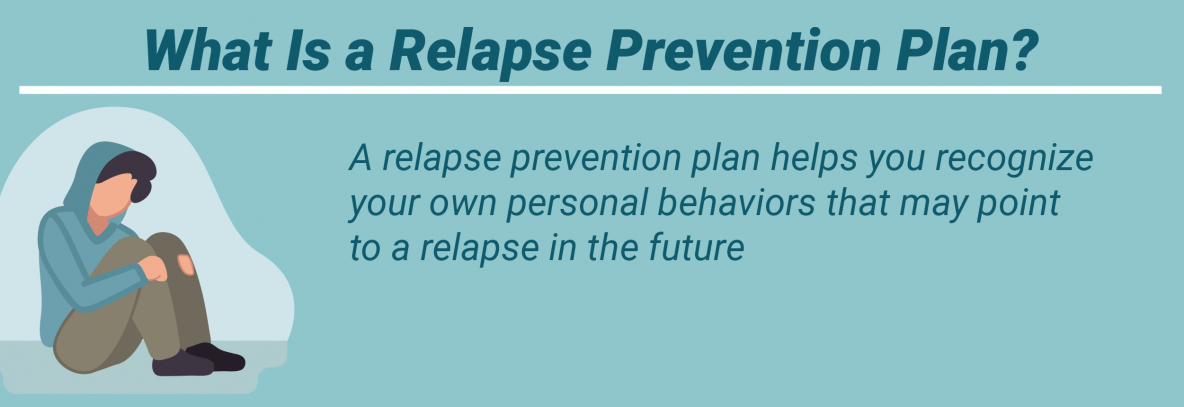
Steps to Creating a Relapse Prevention Plan
While you can create a relapse prevention plan on your own, it may be helpful to walk through the process with someone who has knowledge of the topic like a substance abuse counselor. Relapse plans can be verbalized but may also be written in order to have a more clear outline of what steps to take should a relapse seem to be a possibility.
Regardless, it is important to consider the following items when creating a relapse prevention plan.
1. Assess Your History with Drugs and Alcohol
A few questions to ask yourself when creating a relapse prevention plan include:
- Was there a certain time you were more prone to substance use?
- Didspecific people factor into the times you used?
- What thought patterns make you more likely to use?
- Why did you relapse before?
Determining what caused a prior relapse is vital in avoiding them in the future.
2. Determine Any Signs That Could Lead to Relapse
Try to brainstorm a list of scenarios that could lead to potential relapse and list thewarning signs of relapse. Some people begin to feel, think or behave differently when a relapse is brewing.
Creating a list of warning signs can give a person more insight into their relapse. Sharing the list with the treatment team can provide them with needed information to prevent relapse in the patient.
3. Establish an Action Plan
Create arelapse prevention action planfor what to do instead of turning to drugs or alcohol. For example, if going through a breakup could lead to a relapse, think of other outlets for your pain and frustration. Instead of drinking or using, plan to attend a support meeting or call a family member or close friend right away. The more specific your action plan is, the better, as this means you will be less likely to come within close reach of a relapse.
Know who you will call first, what you will ask of them, and if you will attend a meeting or return to rehab. The more detailed this plan is, the more likely you will be to get yourself back on track quickly. Make sure the people included in your plan have the necessary knowledge should you need their assistance.
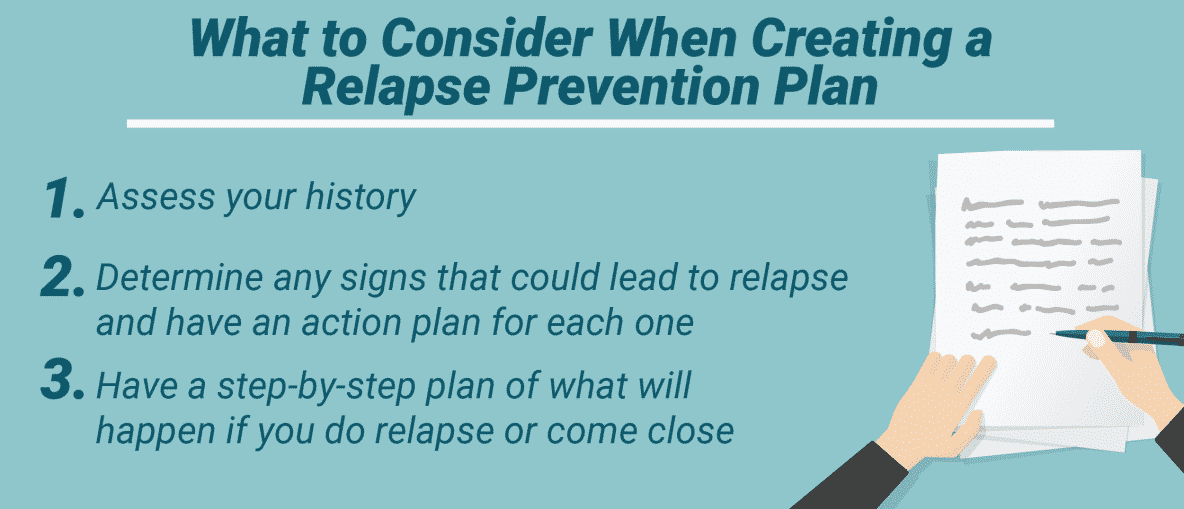
What to Include in aRelapse Prevention Plan Template
Though relapse prevention plans are unique to each individual, there are specific components that are helpful to include in a final plan.
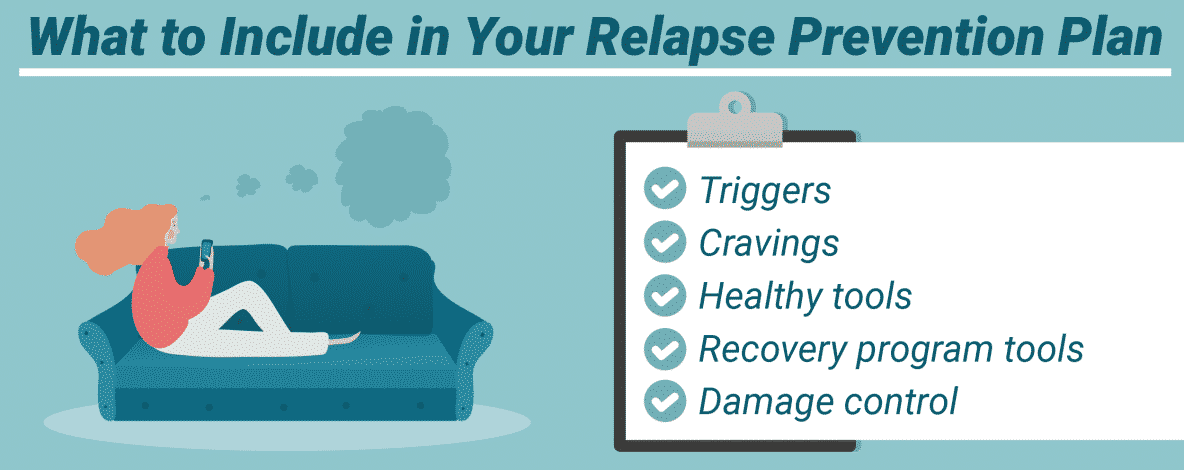
1. Triggers
First, list the people, places and things that have the potential to lead to a relapse.Relapse triggersare anything that could lead to using drugs or drinking again. It may not be possible to list every potential trigger, and sometimes, you won’t know a trigger until it is already in front of you. The following questions could be helpful when identifying triggers:
- Who could I see that would remind me of drug use?
- What places did I use drugs that could trigger me?
- What addictive thoughts could make me relapse?
- What can I do if I cannot avoid things that trigger me?
- Do anniversaries or times of year trigger relapse?
- What feelings are linked to relapse?
2. How to Manage Cravings
The phrase“cravings”is used to refer to the feeling someone has when they wish to use again. Cravings can sometimes lead to a relapse. However, if you have a solid plan to confront such cravings, a relapse won’t be on the radar.
Compile a list of who you can call if you experience cravings, what you can do to distract yourself from cravings and how you can stop a craving altogether. Substance use is a negative coping skill, sohealthy coping skillswill prevent relapse and result in positive outcomes in the long-term.
3. Preventative Tools
Compile a list ofrelapse prevention toolsthat have been helpful in your recovery. Think about what you can do instead of use, and how such activities can point you back on the right track. Some examples of such tools include:
- Continuing programs and support throughonline rehab
- Writing a list of consequences should you relapse
- Attending a support meeting
- Exercising
- Journaling
- Writing a gratitude list
People can be preventative tools as well. Contacting the supportive people in your life can have a tremendous impact on cravings and relapse.
4. Support Groups and Programs
When facing a relapse, it can be helpful to reinvest energy and time intosupport groups. One can revisit the 12 steps and assess their place. This is also where asponsorcomes into play. If you have a sponsor, they should be one of the first people you turn to if you feel like a relapse is a possibility. Since they’ve likely been in your shoes, they may have some insight and suggestions.
Many support group options existoutside of the 12-step model, so don’t let bad experiences stand in the way of your recovery. Explore new options to connect with new people who understand the struggles of addiction.
Related Topic:We Now Offer Teletherapy for Addiction and Mental Health
5. Lifestyle Changes
Relapse prevention plans can include ways in which you hope to amend the damage addiction caused in your life. Separating these damages into areas like relationships, legal issues, financial issues or education can help you regain insight as to why you decided to get sober in the first place and provide motivation to make positive choices.
As time passes, it may be important to revisit your relapse prevention plan. The components you acknowledged in your plan at the beginning of your recovery have the potential to change and develop over time, as do the people in your support system. This can be done on your own or by sitting down with a professional. Each individual’s needs will vary, so it is important to assess where you are in your recovery and to behonest with yourself.
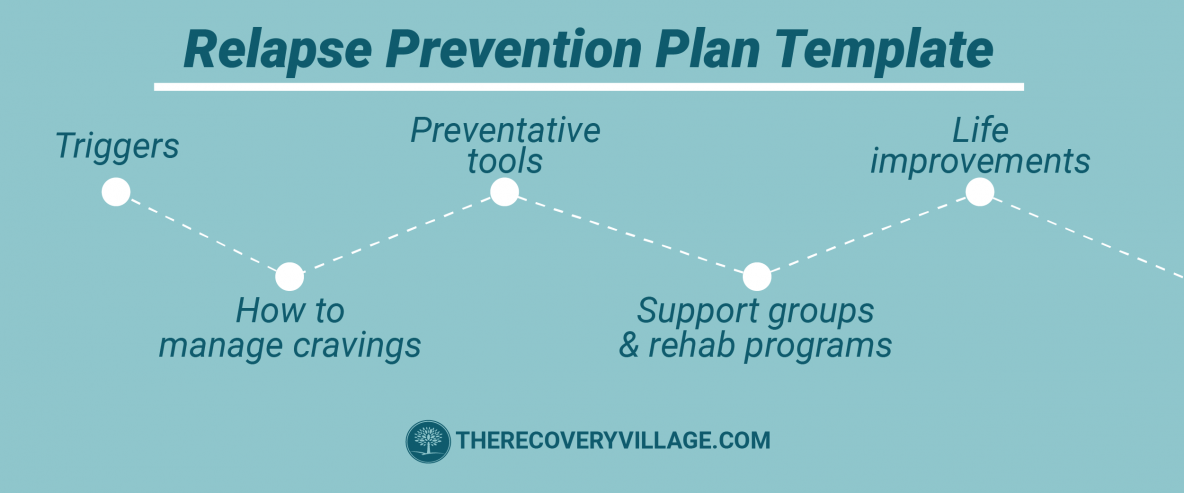
Relapse Prevention Models
Just as there are numerous views on human nature and multipletherapy models, there are different views on relapse prevention. Theserelapse prevention modelsoffer a unique take on the process.
Gorski-Cenaps Relapse Prevention Model
Terry Gorski is an internationally recognized expert within the field of substance abuse, mental health, violence and crime. Within his model he states the following nine steps to be imperative in developing aCENAPS model of relapse preventionor aGorski relapse prevention plan:
- Self-regulation:Physical, psychological, and social stabilization
- Integration:Completing a self-assessment
- Understanding:Educating yourself on relapse signs and prevention methods
- Self-knowledge:Identifying warning signs for when you are likely to relapse
- Coping skills:Managing these warning signs effectively
- Change:Reviewing the recovery plan
- Awareness:This is acquired through practice and consistency
- Support:The involvement of significant others
- Maintenance:A comprehensive follow-up plan
Marlatt’s Model of Relapse Prevention
Dr. Gordon Alan Marlatt, a University of Washington Psychology professor, founded this relapse model centered around high-risk situations.
TheMarlatt Modelillustrates how both tonic (stable) and phasic (short-lived) influences interact with each other in order to evaluate the likeliness of a relapse. The difference between these two variables are that tonic processes represent how susceptible one is to relapse while phasic responses serve as factors that either cause or prevent relapse.
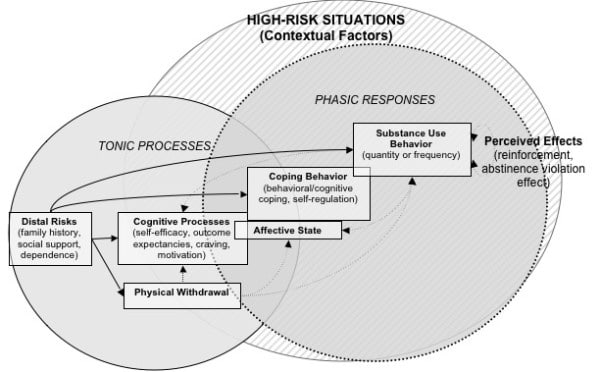
For additional information on the Marlatt modelsee this resource.
Additional Relapse Prevention Workbooks and Worksheets
There are relapse prevention workbooks available to help you maintain sobriety. Many contain worksheets that you may fill out to help you perform self-assessment and evaluation:
- The Mission Consumer Workbook– Maintaining Independence and Sobriety through Systems Integration, Outreach, and Networking
- Relapse Prevention Workbookby Bradley A. Hedges, Ph.D., LPCC Psychologist
- My Relapse Prevention Workbookby Montgomery County Emergency Service, Inc.
- Cognitive Behavioral Relapse StrategiesUnited Nations Office on Drugs and Crime
- Relapse Prevention Workshopfrom Relapse Prevention Therapy And Relapse Prevention Counseling Workbooks
- Relapse Prevention Tool Worksheetsby Peggy Ferguson, Ph.D.
If you or a loved one are struggling with addiction,contact The Recovery Village today. Our trained professionals will help you find treatment options that best suit your needs. Help is available. Reach out today.








